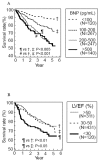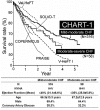Chronic heart failure in Japan: implications of the CHART studies
- PMID: 18629369
- PMCID: PMC2464764
- DOI: 10.2147/vhrm.2008.04.01.103
Chronic heart failure in Japan: implications of the CHART studies
Abstract
The prognosis of patients with chronic heart failure (CHF) still remains poor, despite the recent advances in medical and surgical treatment. Furthermore, CHF is a major public health problem in most industrialized countries where the elderly population is rapidly increasing. Although the prevalence and mortality of CHF used to be relatively low in Japan, the disorder has been markedly increasing due to the rapid aging of the society and the Westernization of lifestyle that facilitates the development of coronary artery disease. The Chronic Heart Failure Analysis and Registry in the Tohoku District (CHART)-1 study was one of the largest cohorts in Japan. The study has clarified the characteristics and prognosis of Japanese patients with CHF, demonstrating that their prognosis was similarly poor compared with those in Western countries. However, we still need evidence for the prevention and treatment of CHF based on the large cohort studies or randomized treatment trials in the Japanese population. Since the strategy for CHF management is now changing from treatment to prevention, a larger-size prospective cohort, called the CHART-2 study, has been initiated to evaluate the risk factors of CHF in Japan. This review summarizes the current status of CHF studies in Japan and discusses their future perspectives.
Keywords: Japanese; aging; heart failure.
Figures






Similar articles
-
Treatment with angiotensin converting enzyme inhibitors, angiotensin-II-antagonists and beta-blockers in an unselected group of patients with chronic heart failure.Eur J Clin Pharmacol. 2005 May;61(3):209-14. doi: 10.1007/s00228-005-0892-y. Epub 2005 Mar 11. Eur J Clin Pharmacol. 2005. PMID: 15761755
-
Characteristics, treatments and 1-year prognosis of hospitalized and ambulatory heart failure patients with chronic obstructive pulmonary disease in the European Society of Cardiology Heart Failure Long-Term Registry.Eur J Heart Fail. 2018 Jan;20(1):100-110. doi: 10.1002/ejhf.964. Epub 2017 Sep 26. Eur J Heart Fail. 2018. PMID: 28949063
-
Addition of losartan to angiotensin-converting enzyme inhibitors improves insulin resistance in patients with chronic heart failure treated without β-blockers.Circ J. 2010 Nov;74(11):2346-52. doi: 10.1253/circj.cj-10-0395. Epub 2010 Sep 4. Circ J. 2010. PMID: 20827028 Clinical Trial.
-
Angiotensin antagonism in patients with heart failure: ACE inhibitors, angiotensin receptor antagonists or both?Am J Cardiovasc Drugs. 2004;4(6):345-53. doi: 10.2165/00129784-200404060-00002. Am J Cardiovasc Drugs. 2004. PMID: 15554719 Review.
-
Drugs, heart failure and quality of life: what are we achieving? What should we be trying to achieve?Drugs Aging. 1999 Mar;14(3):153-63. doi: 10.2165/00002512-199914030-00001. Drugs Aging. 1999. PMID: 10220102 Review.
Cited by
-
Synergistic Effect of Atorvastatin and Folic Acid on Cardiac Function and Ventricular Remodeling in Chronic Heart Failure Patients with Hyperhomocysteinemia.Med Sci Monit. 2018 Jun 4;24:3744-3751. doi: 10.12659/MSM.906893. Med Sci Monit. 2018. PMID: 29863106 Free PMC article.
-
Effect of olfactory stimulation from aromatherapy on the autonomic nervous activity during aerobic exercises.Sci Rep. 2024 May 16;14(1):11198. doi: 10.1038/s41598-024-61732-w. Sci Rep. 2024. PMID: 38755393 Free PMC article. Clinical Trial.
-
Diabetes Management in Patients with Heart Failure.Diabetes Metab J. 2021 Mar;45(2):158-172. doi: 10.4093/dmj.2020.0296. Epub 2021 Mar 25. Diabetes Metab J. 2021. PMID: 33813814 Free PMC article. Review.
-
Heart failure in East Asia.Curr Cardiol Rev. 2013 May;9(2):112-22. doi: 10.2174/1573403x11309020004. Curr Cardiol Rev. 2013. PMID: 23597295 Free PMC article. Review.
-
High serum levels of thrombospondin-2 correlate with poor prognosis of patients with heart failure with preserved ejection fraction.Heart Vessels. 2016 Jan;31(1):52-9. doi: 10.1007/s00380-014-0571-y. Epub 2014 Aug 24. Heart Vessels. 2016. PMID: 25150586
References
-
- Bansal D, Chahoud G, Smith ES, et al. Prevention of heart failure. Curr Opin Cardiol. 2006;21:510–16. - PubMed
-
- Benfante R. Studies of cardiovascular disease and cause-specific mortality trends in Japanese-American men living in Hawaii and risk factor comparisons with other Japanese populations in the Pacific region: a review. Hum Biol. 1992;64:791–805. - PubMed
-
- Bettencourt P, Ferreira A, Dias P, et al. Predictors of prognosis in patients with stable mild to moderate heart failure. J Card Fail. 2000;6:306–13. - PubMed
-
- Deedwania PC. The key to unraveling the mystery of mortality in heart failure: An integrated approach. Circulation. 2003;107:1719–21. - PubMed
-
- Exercise and Physical Activity Reference for Health Promotion 2006. Office for Lifestyle-related Diseases Control, General Affairs Division, Health Service Bureau, Ministry of Health, Labour Welfare [online] Accessed on June 10, 2007. URL: http://www.nih.go.jp/eiken/english/research/program_exercise_epar2006.html
Publication types
MeSH terms
Substances
LinkOut - more resources
Full Text Sources
Medical

